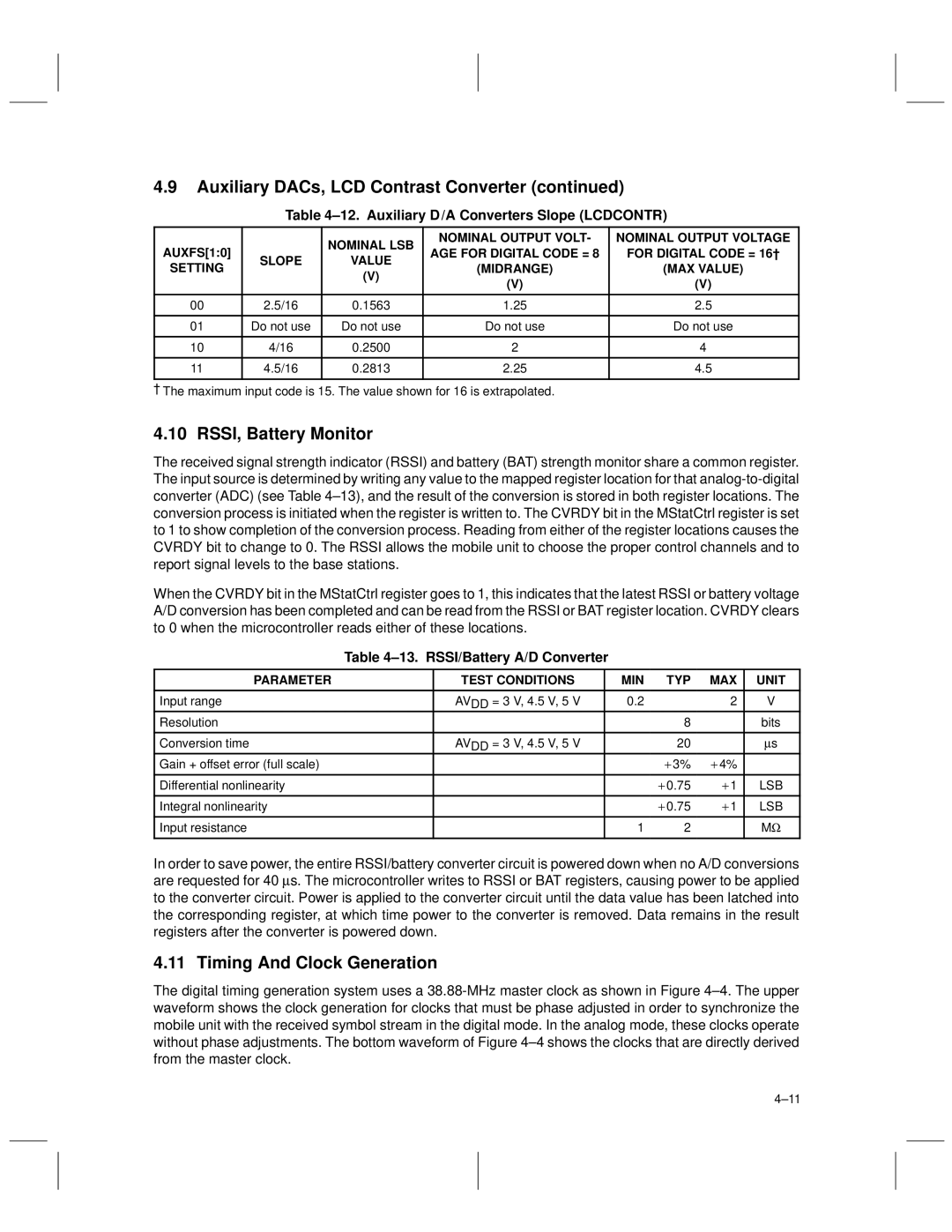Data Manual
SLWS010F
TCM4300 Data Manual
Important Notice
Contents
Mechanical Data ±1
List of Illustrations
List of Tables
Features
Introduction
TCM4300 Functional Block Diagram
VSS
Pin Assignments
PZ Package TOP View
Fmrxen
Terminal Functions
Terminal Description Name
Dvdd
Dsprw
Dspstrbl
Dvss
Mclkin
Mcds
MTS1
Mcrw
Synclk
Scen
Sint
Syndta
Package
Power Rating Above TA = 25C
Dissipation Rating Table
Derating Factor
Reference Characteristics
Power Consumption
Recommended Operating Conditions
Function MIN TYP² MAX Unit
Terminal Impedance
RXIP, RXIN, RXQP, and Rxqn Inputs Avdd = 3 V, 4.5 V, 5
Parameter Test Conditions MIN TYP MAX Unit
Auxiliary D/A Converters
Transmit I and Q Channel Outputs
Parameter MIN TYP MAX Unit
Auxiliary D/A Converters Slope Lcdcontr
RSSI/Battery A/D Converter
Auxiliary D/A Converters Slope AGC, AFC, Pwrcont
Nominal LSB Nominal Output Voltage
Transmit TX Channel Frequency Response Digital Mode
Transmit TX Channel Frequency Response Analog Mode
Page
Mclkout
Mclkout Timing Requirements see ±1 and Note
VOH VOL
Mcrw
Parameter Alternate MIN MAX Unit
Mcds
MCA4±MCA0 MCD7±MCD0 Mccsh Mccsl
Parameter Alternate MIN MAX Unit Symbol
MCA4±MCA0
MCA4±MCA0 MCD7±MCD0
Twdho
Motorola 16-Bit Read Cycle, MTS 10 =
MCA0±MCA4 MCD0±MCD7 Mccsh Mccsl
MCA0±MCA4
Mcrw MCA0±MCA4
MCD0±MCD7 Mccsh Mccsl
10% ThR / W ThWA
Dsprw
Dspcsl
Dspstrbl
Dspa Dspd
±11. TCM4300 to DSP Interface Write Cycle
±12
Mode Fmvox Iqrxen Fmrxen
±1. TCM4300 Receive Channel Control Signals
Control Signal Analog Mode Digital Mode
Data Transfer
±2. RXIP, RXIN, RXQP, and Rxqn Inputs Avdd = 3 V, 4.5 V, 5
Transmit Section
Modulation error percentage +100 s %
±5. Transmit TX I and Q Channel Outputs
±6. Transmit TX Channel Frequency Response Digital Mode
Transmit Burst Operation Digital Mode
±7. Transmit TX Channel Frequency Response Analog Mode
±1. Power Ramp-Up/Ramp-Down TIming Diagram
Transmit I And Q Output Level
Wide-Band Data Demodulator
±9. Bits in Control Register WBDCtrl
±8. Typical Bit-Error-Rate Performance Wbdbw =
Wide-band Data Interrupts
Parameter Test Conditions MIN MAX Unit Mean CNR
Wide-band Data Demodulator General Information
WBD
±10. Auxiliary D/A Converters
Auxiliary DACs, LCD Contrast Converter
±11. Auxiliary D /A Converters Slope AGC, AFC, Pwrcont
Timing And Clock Generation
RSSI, Battery Monitor
±13. RSSI/Battery A/D Converter
±12. Auxiliary D /A Converters Slope Lcdcontr
Microcontroller Clock
Clock Generation
Speech-Codec Clock Generation
Sample Interrupt Sint
Phase-Adjustment Strategy
Mclkin
RCO
Mclken
Frequency Synthesizer Interface
MSB/LSB First
Clkpol Numclks Lowval
Highval
Syndta
±14. Synthesizer Control Fields
Name Description
Name Suggested External Application Reset
Power Control Port
15. External Power Control Signals
Synclk Syndta SYNLE1 SYNLE0 Synrdy
OUT1
Iqrxen Txen Mode
WBD Wbdon
Fmrxen Scen
Fifo a Fifo B
Microcontroller-DSP Communications
Dint
Cint DSP
Microcontroller Register Map
±16. Microcontroller Register Map
±17. Microcontroller Register Definitions
Wide-Band Data/Control Register
Addr Name Category
Microcontroller Status and Control Registers
BIT Name Function Reset Value
±18. WBDCtrl Register
LDC D/A
LCD Contrast
±19. MStatCtrl Register Bits
Lcden
±20. DSP Register Map
DSP Register Map
±21. DSP Register Definitions
Dspcsl TCM4300 Dsprw Dspstrbl Sint Cint Bdint
Wide-Band Data Registers
Base Station Offset Register
DSP Strb INT
DSP Status and Control Registers
±22. DStatCtrl Register Bits
Internal Reset State
Reset
Power-On Reset
±23. Power-On Reset Register Initialization
±25. Microcontroller Interface Connections for Intel Mode
Intel Microcontroller Mode Of Operation
±24. Microcontroller Interface Configuration
Microcontroller Interface
Mcrw Mcds
Mitsubishi Microcontroller Mode of Operation
Motorola Microcontroller Mode of Operation
IRQ NMI Dint
CS3
±32
Mechanical Data
PZ S-PQFP-G100
Important Notice

